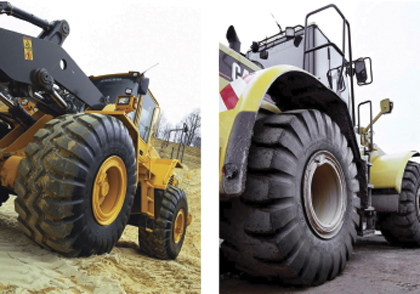When it comes to tires, what performance benefit is most important to you? Are you looking for a tire that provides enhanced cut resistance? Do you want a tire that offers more hours of service? Do you prefer a tire that “stays cool” when running fast and under heavy loads? Are you looking for a balanced combination of all three attributes?
These benefits—cool running, toughness, and cut resistance—make up what we call the tire performance triangle.
In the past, when one aspect of the performance triangle was improved, other elements were sometimes impacted. That dynamic has become less prevalent as tire manufacturers like The Goodyear Tire & Rubber Company develop new technologies and designs to minimize performance trade-offs.
This is not an easy task when you consider the fact that a standard construction tire can contain dozens of separate components that work together as a holistic system.
CRITICAL AREAS
To help achieve a balanced performance triangle, adjustments can be made in one, two, or all of the following areas: tire compounding, tread design, and sidewall construction.
Compounding: It’s easy to imagine that a construction tire might contain only one—or at the most, two or three—compounds. However, up to four to six separate compounds can be found in the crown area of a standard construction tire, from the tread all the way down through the tread base. Compounds can be adjusted to reduce heat buildup and enhance cut protection.
Tread design: What do you think of when you hear the words “tread design?” For many, traction and grip immediately come to mind. However, tread design can play a role in the number of service hours that a tire can offer, as well. And, treads can be designed to help minimize excessive heat buildup. Thanks to advancements in tire mold technology, sipes can be inserted into tread blocks to form tiny “canyons” of rubber through which air can move freely, which helps cool the tire while it rolls. Tread depth is another area that can be adjusted for optimal results, based on underfoot conditions. For example, a tire that boasts a deep tread depth might be more appropriate for a vehicle that rolls across more severe surfaces.
Sidewall construction: Sidewalls help support the tire, so the tire can support the vehicle’s load. However, the heavier the vehicle load, the more a sidewall can bend or deflect. This, in turn, exposes more of the sidewall’s surface area to potentially damaging debris. Strengthening a tire’s sidewall by increasing its thickness, tweaking its compounding, and/or adding reinforcements can mitigate this exposure. Another factor to consider is the sidewall shape from the shoulder to the bead. Reducing deflection in this area can reduce stress and strain.

BEST PRACTICES
For most construction companies, tires represent a substantial investment. We strongly recommend that you work with either a Goodyear Commercial Tire & Service Center or an authorized Goodyear commercial tire dealer to incorporate the following practices into your tire program:
Inflation checks: Maintaining proper inflation levels is the most effective tire maintenance practice you can employ to help promote optimal tire performance and tread life. Check inflation levels before every shift, or at least once a day. Avoid both under- and over-inflation since both can be detrimental to tire performance and longevity.
Tire surveys: By scrutinizing the condition of your tires before each shift begins, you can identify often-overlooked issues that have the potential to grow into bigger problems over time. The benefits of a thorough fleet survey more than make up for the time investment.
Site audits: Look at your site and the roads that lead into and out of it. Are these areas free of debris and standing water? How steep are surface inclines or declines? Are road curves graded properly? Make note of the issues you see and work with your local tire professional to take corrective action.
Retreading is also recommended as an effective way to optimize the return on your tire investment. Today’s retreads and retread operations, such as Goodyear’s OTR facility in North Bay, Ontario, are more technically advanced than ever and are worthy of consideration if extending your casing’s lifecycle is a priority. ■
About the Author
OTR tire veteran Eric Matson is the global field engineering manager for The Goodyear Tire & Rubber Company’s OTR tire business. For more information, visit www.goodyearotr.com.
_________________________________________________________________________
Modern Contractor Solutions, August 2017
Did you enjoy this article?
Subscribe to the FREE Digital Edition of Modern Contractor Solutions magazine.

The Tire Performance Triangle


